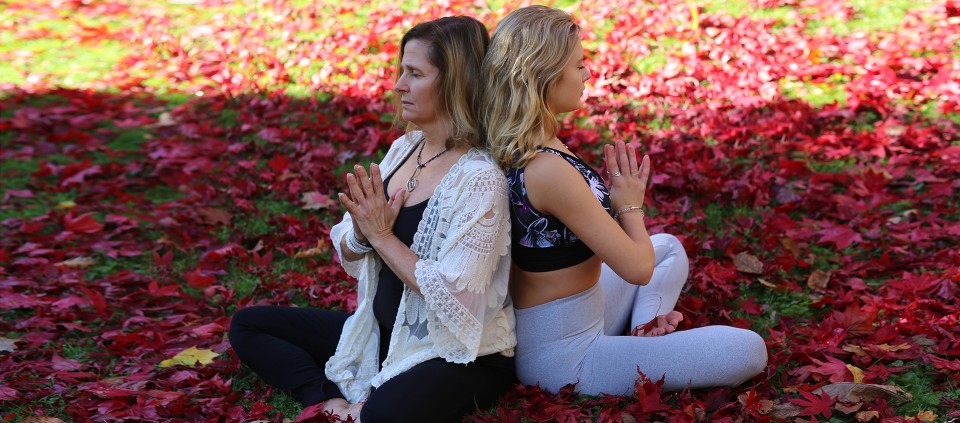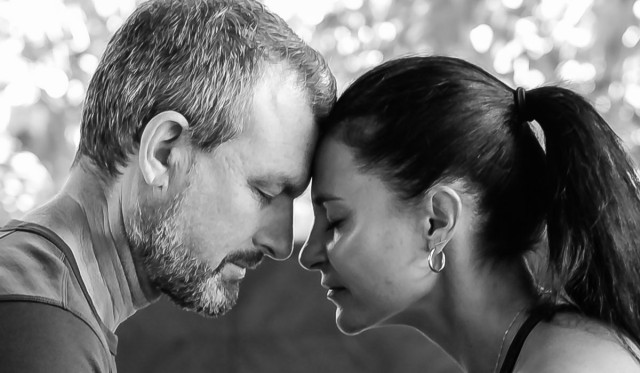A Partner Yoga Practice to Balance the Brain and Body

I love the human body. I love how our physical self constantly reminds us of what is real and alive in us. I love its soft animal nature and how it provides a sense of connection, embodied bliss, and present-moment awareness.
In the words of poet Mary Oliver, “You do not have to be good. You just have to let the soft animal of your body love what it loves.” Yet the body is not just a vehicle for bliss; it is also where we experience pain and discomfort, both physical and emotional. For me, this is simply another reason to appreciate it.
The body is continually reminding us to slow down, breathe, and listen; to become more present with ourselves and each other, and to allow whatever is happening to happen.
Pause and Tune In
Right now, pause, close your eyes, and tune in. Take a few rounds of slow and conscious breath and notice what you notice. It can be this simple and easy to slow down our thinking and come home to our body and the aliveness of the moment. It is also very easy in this digital age to become hypnotized by the continual distractions that surround us—to stay lost in the trance of thought and ignore the messages are body is sending, sometimes quietly, sometimes more forcefully.
Recent research in neurobiology provides fascinating information on the role of the body in brain health. We now know that body awareness is essential for integrating the two hemispheres of the brain. Each hemisphere provides certain vital functions: The right hemisphere connects us to our body awareness and to our emotions; it’s also the hemisphere that is relational and can empathize with ourselves and others.
Bridging Mind and Body
Attuning to the sensations of the body is a simple and direct path to supporting the brain to function more effectively. The practice of yoga, and partner yoga in particular, is a pleasurable and effective way to bring balance to our brain and body. Partner yoga has a balancing effect not only on the hemispheres of the brain but on many of the polarities we experience—between self and other, between yin and yang energy, and between our human and our spiritual natures.
Connecting with others without words softens the mind, opens the heart, and reminds us to enjoy the sweetness of our soft animal bodies. When we simply sit, sacrum to sacrum with another, our nervous system and emotional body receive the message that we are safe and held. Our physical body relaxes, and our subtle body awakens. We directly feel the truth that all spiritual teachings point to—that we are all connected, an integral part of the field of energy that surrounds and embraces us.
Sacrum Connection Practice
This practice is the foundation of partner yoga practice and a powerful way to experience both physical and subtle energies. You can modify the practice using benches or props if needed. Rather than a back-to-back sitting pose, this posture is about creating a powerful connection between sacrum and sacrum. The focus is on establishing and maintaining our own alignment through a strong sacral connection, rather than leaning on our partner.
- Begin in a back-to-back seated position with your partner. Lean forward and shift your pelvis back until you contact your partner’s pelvic bones. Slowly sit upright and align your torso on top of your pelvic bones by drawing the buttock muscles behind you and rolling the thigh muscles inward.
- To experience deeper connection, aim for your partner’s sit bones. Engaging Uddiyana bandha (drawing the lower belly up and in) strengthens the sacral connection. This adjustment is subtle and can easily be overdone. If you do not feel a solid sacral connection, simply move through these steps again.
- Draw your wrists into the hip sockets and squeeze the shoulder blades and elbows together. Feel the lift of your sternum as you do this. Maintain the lift through your torso as you relax your hands back onto your knees.
- Bring your awareness to the sacral connection and direct your breath there. Unhinge the jaw and slightly tuck the chin to create length through the neck and the central axis of the body. If you notice your partner is beginning to lean on you, gently tap your partner’s hips with your fingers to remind them to keep the sternum lifted.
- Relax deeply, and fully receive the support of both your partner and the ground. Notice how your partner’s presence brings you more deeply into your own being. Play with moving your awareness back and forth between being deeply in your own form and merging with your partner’s. It is through relaxing the physical body that we experience the subtle body. Sense the distinction between awareness of yourself and awareness of your partner. Sense the subtle prana generated between you. Let go of all preconceived ideas concerning yourself and your partner, and instead rest in the experience of essential sameness.
The body is a profound mirror of the Soul, the vehicle within which we experience our humanity. Partner yoga is a precious and joyful way to honor our bodies while building a bridge between our humanity and divinity.
Elysabeth Williamson, E-RYT 500, internationally recognized as the foremost authority on partner yoga, is author of The Pleasures and Principles of Partner Yoga.
Full Bio and Programs
